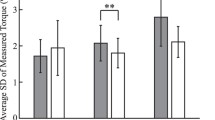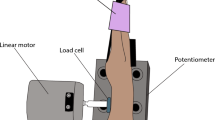Abstract
In order to study the roles of muscle mechanics and reflex feedback in stabilizing movement, experiments were conducted in which healthy human subjects performed targeted wrist movements under conditions where the damping of the wrist was reduced with a load having the property of negative viscosity. If the movement speed and negative viscosity were sufficiently high, the wrist oscillated for several hundred milliseconds about the final target position. Subjects increased the activation of both wrist flexor and extensor muscles to increase joint stiffness to damp the oscillations. With practice, both the tendency to oscillate and the level of muscle activation were reduced. A small bias torque in either direction, added to the negative viscosity, enhanced the oscillations as well as the amount of flexor and extensor muscle activation during the stabilization phase of fast movements. The tendency for the wrist to oscillate was also seen during slow movements where the oscillations were superimposed upon the voluntary movement. We suggest that this reduction in mechanical stability is primarily of reflex origin. As wrist stiffness increases, the natural frequency of the wrist also increases, which in turn produces an increase in the phase lag of the torque generated by the myotatic reflex with respect to wrist angular velocity, effectively reducing damping. The oscillation frequency was often close to a critical frequency for stability at which torque, due to the myotatic reflex, lagged angular velocity by 180° (6–7.5 Hz). Nevertheless, subjects were able to damp these oscillations, probably because the torque due to intrinsic muscle stiffness (in phase with position and hence lagging velocity by only 90°) dominated the torque contribution of the myotatic reflex. Increasing stiffness with declining oscillation amplitude may also have contributed significantly to damping.
Similar content being viewed by others
References
Bennett DJ, Hollerbach JM, Xu Y, Hunter IW (1992) Time-varying stiffness of human elbow joint during cyclic voluntary movement. Exp Brain Res 88: 433–442
Brooke JD, McIlroy WE, Collins DF (1992) Movement features and H-reflex modulation. 1. Pedaling versus matched controls. Brain Res 582: 78–84
Brown TIH, Rack PMH, Ross HF (1982) Forces generated at the thumb interphalangeal joint during imposed sinusoidal movements. J Physiol (Lond) 332: 69–85
Capaday C, Stein RB (1986) Amplitude modulation of the soleus H-reflex in the human during walking and standing. J Neurosci 6: 1308–1313
Capaday C, Stein RB (1987) Difference in the amplitude of the human soleus H reflex during walking and running. J Physiol (Lond) 392: 513–522
Colgate JE, Hogan N (1988) Robust control of dynamically interacting systems. Int J Control 48: 65–88
De Serres SJ, Milner TE (1991) Wrist muscle activation patterns and stiffness associated with stable and unstable mechanical loads. Exp Brain Res 86: 451–458
Dufresne JR, Soechting JF, Terzuolo CA (1980) Modulation of the myotatic reflex gain in man during intentional movements. Brain Res 193: 67–84
Gielen CCAM, Houk JC (1984) Nonlinear viscosity of human wrist. J Neurophysiol 52: 553–569
Hunter IW, Kearney RE (1982) Dynamics of human ankle stiffness: variation with mean ankle torque. J Biomech 15: 747–752
Joyce GC Rack PMH, Westbury DR (1969) The mechanical properties of cat soleus muscle during controlled lengthening and shortening movements. J Physiol (Lond) 204: 461–474
Joyce GC, Rack PMH, Ross HF (1974) The forces generated at the human elbow joint in response to imposed sinusoidal movements of the forearm. J Physiol (Lond) 240: 351–374
Lacquaniti F, Licata F, Soechting JF (1982) The mechanical behavior of the human forearm in response to transient perturbations. Biol Cybern 44: 35–46
Lacquaniti F, Borghese NA, Carrozzo M (1991) Transient reversal of the stretch reflex in human arm muscles. J Neurophysiol 66: 939–954
Lakie M, Walsh EG, Wright GW (1984) Resonance at the wrist demonstrated by the use of a torque motor: an instrumental analysis of muscle tone in man. J Physiol (Lond) 353: 265–285
Milner TE (1993) Dependence of elbow viscoelastic behavior on speed and loading in voluntary movements. Exp Brain Res 93: 177–180
Nichols TR, Houk JC (1976) Improvement in linearity and regulation of stiffness that results from actions of stretch reflex. J Neurophysiol 39: 119–142
Prochazka A, Trend PS. J (1988) Instability in human forearm movements studied with feed-back-controlled muscle vibration. J Physiol (Lond) 402: 421–442
Rack PMH (1981) Limitations of somatosensory feedback in control of posture and movement. In: Brooks VB (ed) The nervous system. (Handbook of physiology, Vol II) Williams and Wilkins, Bethesda, pp 229–256
Riek S, Bawa P (1992) Recruitment of motor units in human forearm extensors. J Neurophysiol 68: 100–108
Soechting JF, Dufresne JR, Lacquaniti F (1981) Time-varying properties of the myotatic response in man during some simple motor tasks. J Neurophysiol 46: 1226–1243
Author information
Authors and Affiliations
Rights and permissions
About this article
Cite this article
Milner, T.E., Cloutier, C. Compensation for mechanically unstable loading in voluntary wrist movement. Exp Brain Res 94, 522–532 (1993). https://doi.org/10.1007/BF00230210
Received:
Accepted:
Issue Date:
DOI: https://doi.org/10.1007/BF00230210




